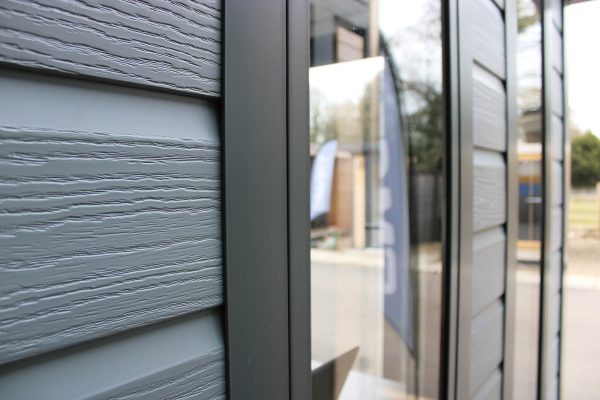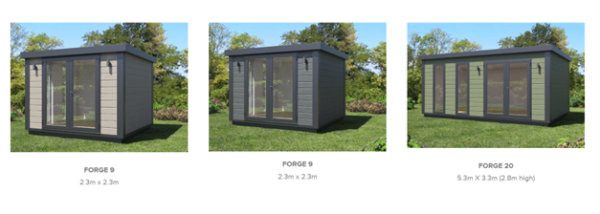What are the Benefits of a Garden Room Living Roof?
At SMART Garden Offices, we believe that our garden rooms should reflect the design and lifestyle choices of our customers. That’s why we could not be prouder of the launch of our Forge range, which is one of the most sustainable garden rooms on the market. Not only does it boast an eco-friendly Net Zero construction, delivery and installation, it features a garden room living roof as an optional extra. So we thought we’d take this opportunity to explore the benefits of living roofs.
What is a Garden Room Living Roof?
A garden room living roof, also known as a grass top or sedum roof, is covered with vegetation, growing medium and a waterproof membrane to provide the following benefits:
- Increased biodiversity. Garden room living roofs provide a rich habitat for birds, insects, and other wildlife, which can help to increase biodiversity, especially in more urban areas.
- Energy efficiency. With added thermal efficiency, living roofs help to reduce heat loss during the winter months and heat gain during the summer, leading to lower energy consumption.
- Improved air quality. Since vegetation absorbs carbon dioxide and other pollutants from the air to produce oxygen, living roofs improve air quality.
- Noise reduction. All our garden rooms are extremely well insulated, but a living roof can lessen noise even further. This is super handy if you’re running a business from your garden room where noise is unavoidable.
- Rainwater management. Although we don’t get too much stormwater in the UK, living roofs are excellent at absorbing rainwater and reducing runoff, which is a benefit during the wetter months.
- Aesthetic appeal. Adding vegetation to a garden room roof enhances the design, especially in the summer months where the green hues offer a particularly vibrant contrast against the cladded exterior. Living roofs may also provide habitat for rarer or endangered bird species, especially in Norfolk and Suffolk, which welcome a huge variety of migratory birds every year,

How does a Living Garden Room Roof improve biodiversity?
Garden room living roofs can enhance biodiversity in several ways. Before we go into detail, it’s helpful to understand what a living roof consists of. Usually, a garden room roof is covered with beautiful mosses, sedum, grasses and flowering herbs. This vegetation creates a wonderful little habitat for flora (plants) and fauna (animals – birds and insects).
So, when you introduce a living roof to your garden, you provide an undisturbed natural habitat for species to thrive.
Having a garden room living roof can also reduce habitat fragmentation, which is where urban living prevents wildlife from moving between habitats. By creating a ‘home’ for plants, birds and insects, you provide a new, more connected habitat that supports movement, and therefore, biodiversity.
Cleverly, the soil and vegetation on garden roofs can help to reduce what is known as the ‘urban heat island effect,’ which is why more cities are creating green spaces. Essentially, the greater the number of biodiverse habitats, the cooler the temperature becomes, which can make urban areas appealing to a wider range of species.
What types of Birds and Insects are Attracted to Living Roofs?
The birds and insects attracted to a living roof will depend on the type of vegetation and your location, but for the most part you can expect to welcome:
- A wide variety of birds. Common birds that can be found on living roofs include sparrows, finches, wrens, robins and swallows. In some cases
- living roofs may also provide habitat for rarer or endangered bird species, especially in Norfolk and Suffolk, which welcome a huge variety of migratory birds every year.
- Bees. Living roofs can provide a fantastic habitat for wild bees, which are in decline. Moreover, bees are important pollinators for many plants, and can help to support the growth and reproduction of plants within the garden and on a living roof.
- Butterflies. Believe it or not, butterflies do not just require nectar-rich flowers to survive, they also need a safe place, among plants, to lay their eggs and support the growth of their caterpillars. So, you’ll find lots of them fluttering in and around your garden.
- Ladybirds. A frequent visitor of garden room living roofs, ladybirds are known for their role in controlling aphids and other plant pests, which can help to keep your roof plants healthy.
- Hoverflies. Not to be confused with wasps, hoverflies are also attracted to living roof plants, and much like bees, are excellent pollinators, which will help keep the rest of your garden flowers in good condition.
How does a living Garden Room Roof Reduce CO2?
Living roofs reduce carbon dioxide (CO2) through a process called carbon sequestration. Sequestration is where plants absorb carbon dioxide from the air during photosynthesis and store it in their tissues. During photosynthesis, plants use sunlight, carbon dioxide, and water to produce glucose (a type of sugar) and oxygen. The glucose is used as energy for the plant, while the oxygen is released back into the atmosphere.
Now, we can’t speak for every manufacturer, but we know that the Forge garden room living roof can absorb up to 110kg of CO2 per year.
While the impact of a single garden room living roof may be relatively small, widespread adoption of living roofs can massively reduce carbon emissions, which is a movement we’re delighted to support.
What options does SMART Garden Offices have for living roofs?
Our Forge garden room, the latest addition to our range, can be made with a living roof. Everything about the Forge garden room has been purposely designed to be eco-friendly. Its innovative zero timber construction, with recyclable steel frame and composite style eco-friendly cladding, makes its construction Net Zero. As part of our commitment to offsetting the carbon footprint of the delivery and installation of each Forge garden room, we also partner with Tree-Nation, a leading planter of trees and other carbon offsetting schemes for businesses and community groups.
Crucially, the Forge garden room has been designed with zero maintenance in mind. Being made from cladding that does not discolour or fade in the sun, your garden room will continue to look as fresh as the day it was installed. Harder than regular cladding, the Kerracore technology cladding is also more resistant to scratches and scuffs and has an authentic wood effect, which we absolutely love.

Installed in as little as 1-2 days, there are three sizes to choose from:
- 1m x 2.1m – perfect for a single garden office
- 6m x 2.6m – again, ideal for an office or garden hobby room
- 3m x 3.3m – great for entertaining, lounging and working.

Design your own Eco-friendly Garden Room
As with all our garden room ranges, we’ve made it easy for you to play around with different designs, sizes and finishes using our garden room configurator. Suitable for laptop, desktop PC and tablet use, you simply choose the range that best suits you. Next, you enter your preferred size (there are 60+ sizes in our more established ranges) and place windows, doors and other fixtures and fittings wherever you wish to create ‘your space’.
Then, when you’re ready, you can visualise exactly what your garden room design will look like by viewing your creation with our SMART garden room visualiser app, which is available for download on App Store and Google Play.
You’ll absolutely love the sense of freedom that you get in creating your eco-friendly garden room!
